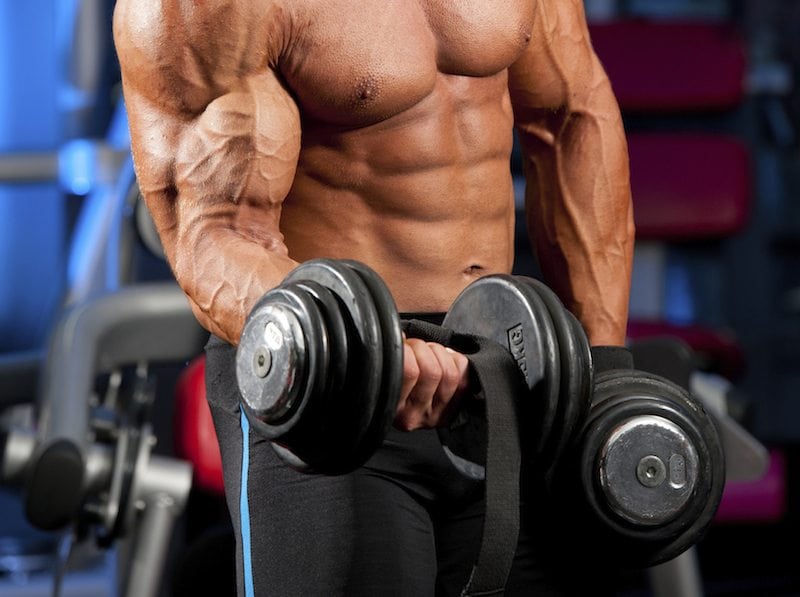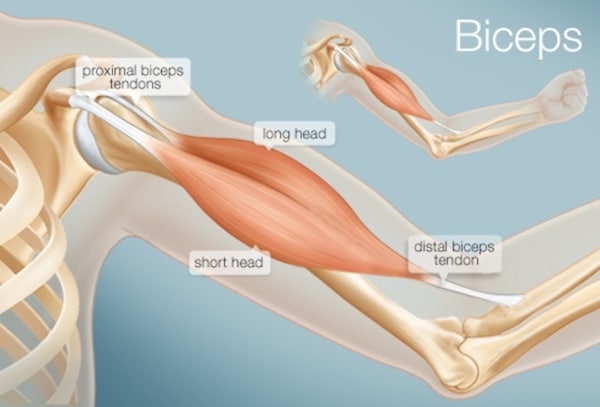No products in the cart.
How to Get Huge Biceps : Tips To Build Bigger Biceps

We all want bigger biceps, well maybe not all of us – but certainly a large number of regular gym-goers do.
One of the most common exercises you see in the gym are bicep curls, they’re probably only second behind the bench press.
So how come so few people have huge biceps then? Well, the main reason is that a lot of people tend to make big bicep mistakes that limit growth.
Are you ready to huge biceps? Well, I would suggest that you read on and see what suggestions we have for you.[toc]
What Are The Biceps?

The biceps brachii is the muscle on the front area of your upper arm.
The term “biceps” alludes to two converging muscle heads: the short head and the long head.
The short head of the biceps starts on the coracoid methodology of the scapula, while the long head begins on the supraglenoid tubercle. The long and short heads converge to embed on the outspread tuberosity.
Training Tips for Huge Biceps
Here are some tips that you can use to get bigger biceps:
#1: Use The Full Range of Motion
This is a common issue and is purely the result of pure laziness or ego.
Having a poor range of motion during a bicep curl will prevent you from getting optimal growth.
This is because fewer muscle fibres will be activated, meaning there will be less muscle damage. Having less muscle damage will result in less hypertrophy.
In 2014 a study by McMahon et al found that full range of motion delivered greater strength and hypertrophy gains when compared to a shortened range of motion [1].
Even though the shortened range of motion allowed for a heavier load to be used. If you quarter rep a barbell bicep curl at 70kg it is going to be less effective than a full rep bicep curl – even if the weight was 40kg or less!
#2: Don’t Ignore Compound Lifts
When most people think about bicep exercises, they normally think about isolation movements such as the bicep curl. But there are many compound exercises (movements that work multiple muscles at once) that also work the biceps.
Not only are these a great way to cut down the number of exercises required. They are also a great way to train the individual muscles.
For example, the underhand pull up (or chin-up) mainly works the muscles of the upper back, but also works the biceps.
In fact, the humble chin-up may have some advantages as you are now lifting your body weight, you are also completing a full range of motion for the biceps.
Try adding pull up, chin-ups, and underhand bent over rows into your program and you should start seeing rapid results.
#3: Wrong Reps
Whilst you can get hypertrophy using any rep range, a lot of fitness coaches believe that some muscles respond better to certain rep ranges depending on their muscle fibre type.
It is believed that the bicep muscles respond best to low rep, heavyweights rather than high reps and low weight. This is because the Bicep Brachii muscle is made up of 60-65% type II muscle fibres [2].
This does not mean that you can’t mix it up rep-wise. Adding the occasional drop-set or back off set could really upgrade your session.
However, if you don’t have some heavy-as-hell bicep curls (performed with the full range of motion of course) then you are definitely making a big mistake.
#4: Focus On Your Task At Hand
It is important when building muscle mass to solely focus on the task at hand, whilst avoiding the distractions and pointless desire of shapely and well-defined biceps.
Whilst you’re packing on mass in an attempt to reach those previously unobtainable fitness goals, your biceps will begin to take shape and develop at a steady yet maintainable pace.
#5: Lift Heavy
If you find yourself wanting to gain as much mass as possible, similar to that of professional athletes, then the heavier weights you opt for during your routine, the better the overall results of your programme will be.
The best place to begin on this path is to curl with a weight that becomes increasingly difficult to lift between the 6th and 8th repetition.
You should only alter the weight when you’re able to achieve 3 full sets of 10 reps.
#6: Push Past Your Limits
During the development stage of your arms taking shape, it is important to remember the significant and positive difference that shaping, peaking and separating biceps can offer your routine.
Peaking, in the general sense, refers to pushing past that in which you regarded as unachievable.
When we lift a certain weight and maintain that movement, we believe that we couldn’t possibly improve that lift and receive even better benefits. This is where many fall short of achieving those powerhouse biceps.
By incorporating even the simplest of movements changes. Such as widening your elbows as you hold a bicep curl so that the inside of your arm is parallel to the floor, we are able to maximize the muscle-building fibres and reap the rewards of this increased intensity.
#7: Stretch Thoroughly
Whether you’re aiming to build mass or to simply cut fat and tone up, no routine should be regarded as complete without flexing/stretching between sets.
When it comes to positive health benefits, stretching in between sets can help lengthen the biceps, which is very important as the more elongated the muscle is, the larger it will be when it is contracted.
Pre-set stretching is also useful for keeping the biceps loose during your routine, and when you inevitable work your way up to doing supersets, this is more than evident.
#8: Isolate The Muscle With Dumbbells
If like many other aspiring bodybuilders and muscle building enthusiast, cutting is part of your routine, then you’ll want to perform the majority of your exercises using dumbbells.
Performing these exercises with dumbbells will allow you to more effectively isolate and focus your attention on each individual bicep. This will give you the chance to cultivate even greater cuts and definition than previously possible.
#9: Get Plenty Of Rest
You may feel that working out all the time will help your biceps to grow, yet your muscles really get stronger during the resting period in between workouts.
This is the when they have room to recoup and, in turn, develop.
You should only train your biceps at most twice a week for the best results.
Work out different parts of your body on the other days while you give your biceps time to rest.
#10: Limit The Time You Train
Another important thing that you want to do is limit the length of your sessions. Training for too long throughout any given session can strain your biceps, setting back your advancement.
Your arm muscles are more delicate than the other muscles in your body, so it’s vital not to put them under a lot of unnecessary strain. Take 45-second breaks between sets to let your muscles rest as well. This will help to prevent injury.
#11: Get Adequate Nutrition
Nutrition is another important part of building your biceps.
Reduce the number of unhealthy foods that you eat. Instead, when you are training all of the time, you have to ensure you get a lot of calories so that you have enough energy.
Yet consuming a lot can cause a layer of fat to appear on your body that will reduce the appearance of those muscles you are working so hard to build.
Pick vegetables, fruits, and whole grains, and make sure to drink a lot of water to keep your body hydrated.
It is incredibly important that you consume a considerable measure of protein, as the protein helps develop muscles. It helps to aid the repair of the muscles broken during training.
Consume poultry, fish, hamburger, pork, eggs, and different sources of protein to help develop your muscles. Beans, leafy greens, tofu, and other vegetarian offerings of protein are likewise great options.
What Are The Best Exercises For Building Huge Biceps?
There are a few exercises that you can do in order to push your biceps to their limit.
#1 – Barbell Biceps Curls
The first exercise you should perform if you want huge biceps is the barbell bicep curl.
When performing this exercise it is important that you do not stop the movement short or lean back while performing the exercise.
You should also try not to swing the weight as you want your muscles to work not gravity.
For best results, the barbell bicep curl should be performed slowly and under control.
#2 – Incline Dumbbell Curls
If you want to avoid the momentum issue associated with Barbell Bicep Curls then Incline Dumbbell Curls are for you as this exercise restricts the movement of your back.
Don’t be surprised though if you are unable to lift as much doing this exercise, just make sure you are still pushing yourself hard while maintaining good form.
#3 – Cable Curls
To develop the deep tissue muscle fibres then cable curls are the way to go.
Cables are less stable than the barbell or dumbbell so you are going to be straining the stabilisation muscles that surround the bicep while performing this exercise.
#4 – Reverse Grip Rows
These will place more stress on your bicep that traditional straight rows so will give you an exercise that focusses on your bicep.
#5 – Concentration Curls
The final exercise to consider is the Concentration Curl, which if done while sitting will place greater emphasis on the bicep as your movement will be restricted.
This is one of the best exercises to perform at the end of a workout to fully exhaust them.
In Conclusion
Hopefully, the above tips and suggested exercises coupled with adequate nutrition will give you those huge biceps you dreamt of.
Remember, muscle growth won’t occur overnight. So our final tip for you would be to be patient. It may take a few months before you see any real difference, but the effort will be worth it!
Save
